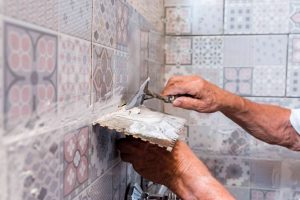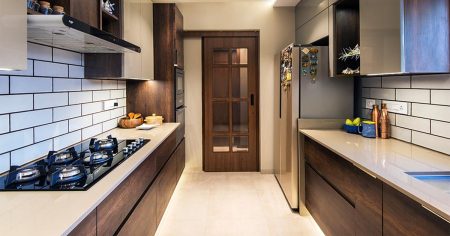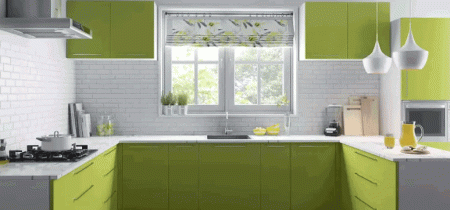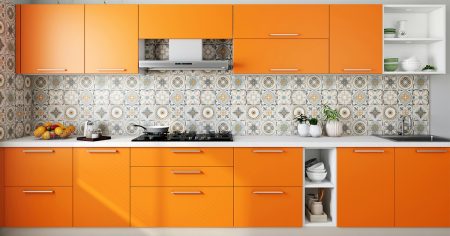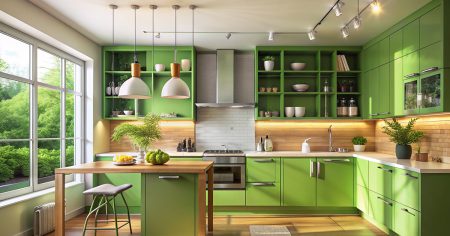You can easily spend $20 to $30 per square foot on luxury flooring for your kitchen, but if you are willing to shop around and tackle the installation yourself, a new kitchen floor can cost well under $1 per square foot. However, it’s important to note that price is not the only consideration. The material also must be a good candidate for the kitchen environment. Any legitimate option must meet two conditions:
- It must be DIY-friendly: Saving real money is only possible if you can install the flooring yourself. If you have to hire out the installation, it won’t be a cheap floor, even if the materials themselves are inexpensive.
- It must be durable and easy to clean: If you have to replace the flooring in a few years, either because it’s dingy or falling apart, it’s not a bargain.
The four best options that meet these guidelines for cheap kitchen flooring are ceramic tile, vinyl, laminate, and cork. That’s actually a fairly broad list, considering that all of these flooring materials are available in a wide range of styles. And they are all pretty good performers in the kitchen.
The costs given below are recent prices from a national big-box home improvement retailer. They are subject to change and do not include underlayment, adhesive, grout, or other installation supplies. Consider those additional costs when evaluating any flooring.
Vinyl Flooring
Available in sheets, tiles, or luxury vinyl planks, vinyl flooring is the easiest kitchen flooring material to install. If your subfloor is in good shape, vinyl is also the cheapest because you can usually install it right over the subfloor (or suitable existing flooring), avoiding the expense of new underlayment. Vinyl comes in several types, so you can shop based on price, look, and/or installation method. The most inexpensive type of vinyl tends to be peel-and-stick tile, followed by peel-and-stick planks and sheet vinyl.
The best all-around DIY option is the luxury plank, which is usually thicker than standard vinyl tile and can be installed as a click-together floating floor.
Prices
Prices for good-quality vinyl flooring start at $.50 per square foot for economy vinyl sheets, and $1.50 to $2.00 per square foot for standard tiles; you will have literally hundreds of options. Good-quality luxury vinyl planks start at about $3 per square foot, with many very attractive options available in the $3 to $4 range.
Advantages
Vinyl flooring is one of the best-performing materials for a kitchen floor, with several notable advantages:
- One of the most inexpensive of all flooring materials
- A resilient surface that is easy on the feet
- Very easy to clean with simple damp mopping
Disadvantages
Vinyl flooring has one main drawback:
- Vinyl can be gouged or scratched rather easily.
Installation Tips
For tiles: Dry-lay a full row across the width and length of the floor to establish a layout, then draw perpendicular layout lines to guide the installation.
For sheet vinyl: Create a perimeter template with butcher paper, and cut the flooring in one piece—a no-glue method (using double-sided tape in select areas) is easiest.
For luxury vinyl planks: Allow the planks to acclimate in the room for a full 48 hours before installation. Use layout lines to guide the installation.
Laminate Flooring
Laminate is one of the most popular of all inexpensive flooring materials, mostly because it can convincingly mimic so many other more expensive flooring materials. Laminate flooring can be manufactured to look like hardwood, natural stone, or even slate.
Laminate flooring has a rightful place among cheap kitchen flooring options, but it’s not the most durable choice for this room—despite what the manufacturers may promise. The hard resin surfaces of the planks are plenty scratch- and stain-resistant enough to tolerate kitchen traffic and abuse, but the seams between planks are vulnerable to water damage. A leaky dishwasher or forgotten spill can cause the planks to bulge along the edges, so you must be mindful of standing water, and avoid wet-mopping altogether (occasional damp-mopping is okay). If you’re willing to spend more, consider “water-resistant” laminate, which is guaranteed to resist standing water for a specified period (such as 24 hours).
Prices
Prices for laminate flooring start at about $0.50 per square foot for standard flooring and about $2 per square foot for water-resistant laminate. Even top name brands rarely cost more than about $3 per square foot.
Advantages
Laminate flooring’s advantages include:
- Can convincingly mimic wood, ceramic tile, stone, and other premium floor coverings
- Surprisingly easy installation for DIYers
Disadvantages
For kitchens, laminate flooring does have some negatives to consider:
- Not ideal for areas where moisture is an issue
- Can be scratched
- Underlayment and trim pieces can add substantially to installation costs
- Should not be cleaned by wet-mopping
Installation Tips
Installing a laminate floating floor in the kitchen is a doable day-long project. Be very careful with the plank edges during installation; they break easily. Plan the plank layout so you don’t end up with a really short piece at either end of a row or a really narrow strip at either side of the room.
Ceramic Floor Tile
Ceramic tile gives you the most bang for your buck because you get a virtually indestructible surface that’s easy to clean—although the grout lines can be difficult to keep clean unless you seal them carefully. If properly installed, bargain tile lasts just as long as the most expensive tiles. Cheap tiles may be less trendy, but if you go for a clean, simple style, no one will be the wiser.
The biggest cost savings with ceramic tile is in the money you save from DIY installation. Professional tile work can cost as much as $14 per square foot.
Prices
Prices for ceramic tile start at about $0.50 per square foot for plain solid-color tile, although there additional costs for underlayment, thin-set adhesive, and grout. Good-quality porcelain tiles that mimic the look of wood or natural stone begin at about $3 per square foot.
Advantages
Ceramic tile is a classic kitchen flooring material, with virtues that include:
- A very elegant flooring surface
- Extremely durable—can last for decades
- Surfaces are easy to clean
Disadvantages
Ceramic tile has some disadvantages when used in kitchens:
- A very hard surface that leads to fatigue; dropped dishes may shatter
- Can be a cold surface on the feet
- Grout joints are prone to trapping dirt and stains
- A more complicated installation than most other types of flooring
- Additional materials needed can significantly add to the overall cost
Installation Tips
Install the tile over a layer of cement board, which helps stiffen the floor (to prevent cracking) and isn’t affected by moisture that gets through the tile. Plan your layout carefully to ensure that the results are pleasing to the eye.
Cork
Cork is at the higher end of inexpensive flooring options, but it’s a comfortable and visually pleasing material that’s easy to install. It offers more cushion underfoot than the others and is quite long-lasting. You might have to shop around to find cork as low as $3 per square foot, but it is available.
Cork is most commonly sold as snap-together planks or tiles for a floating floor installation, similar to how laminate flooring is installed. This makes cork a good DIY option, and many types of cork do not require the foam underlayment that is necessary with laminates, since the planks have a layer of built-in underlayment.
Prices
Cork flooring starts at about $3 per square foot for click-lock planks. The higher-end cork flooring products available at home centers cost about $8 per square foot.
Advantages
The advantages of cork flooring in a kitchen are few but very important:
- Very comfortable for the feet
- Easy installation
Disadvantages
Though they don’t outweigh the advantages, there are some drawbacks to cork flooring in a kitchen:
- A bit more expensive than other flooring options
- Not as durable as ceramic tile
- Can be damaged by high heels, sports cleats, and pet claws
Installation Tips
Plan the layout of the planks so you don’t end up with a really short piece at either end of a row or a really narrow strip at either side of the room.
Use a tapping block to hammer the pieces together and lock the joints. Hammering directly on the planks can break them.
Read the full article here




